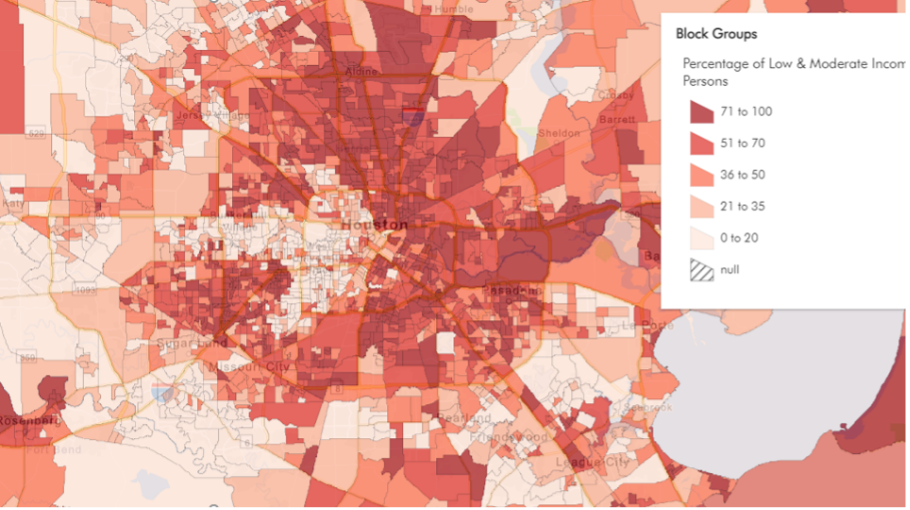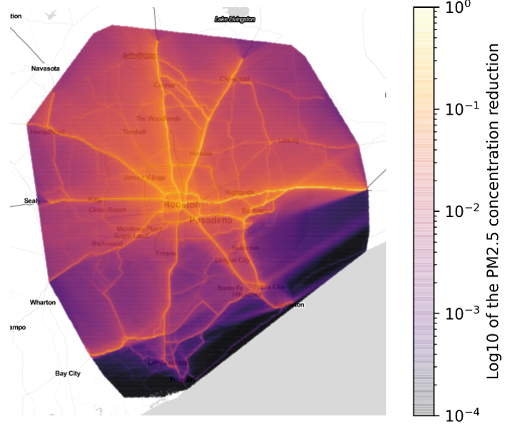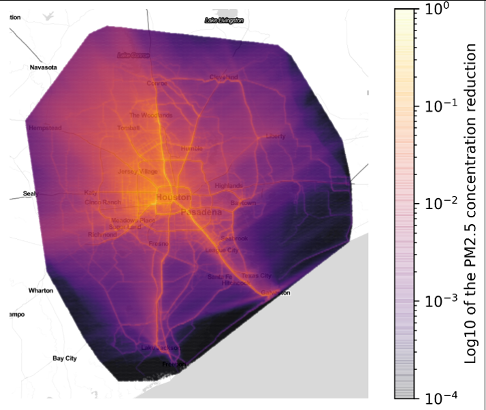We know that electrifying trucks, as we wrote last month, can reduce significant amounts of air pollution; it can also have significant health benefits, particularly for frontline communities. Analysis by Alexander Meitiv and Ann Xu for Texas A&M’s Transportation Institute finds that, by electrifying just 40% of existing, predominantly diesel-fueled medium-and heavy-duty vehicles in the eight-county Houston area, Texans could avoid more than 21 tons of nitrogen oxides (NOx) – over a quarter of the 80 tons a day emitted per day by Greater Houston’s on-road traffic. This could be achieved by electrifying a little over 60,000 medium-and heavy-duty vehicles, about 1% of all the vehicles in greater Houston.
This is big news for all areas in non-attainment for ozone under the Clean Air Act, a serious public health and economic challenge. But it is especially big news for people living near highway corridors, because electrifying the same vehicles also reduces fine particle emissions by nearly 20%.
Fine Particulates Are Deadly
Tailpipe emissions from medium- and heavy-duty diesel trucks contain significant amounts of fine particle pollution, also referred to as “PM2.5.” PM2.5 are particles that are 2.5 microns or smaller that are produced along with partially combusted fuel and from other pollutants like nitrogen and sulfur oxides. (To get a sense of just how small 2.5 microns is, the diameter of a human hair is around 50 microns.)
The World Health Organization’s International Agency for Research on Cancer characterizes PM2.5 as a carcinogen, and for decades, we have known that PM2.5 causes premature mortality. In the proceedings of the National Academy of Sciences research indicates that roughly 100,000 Americans per year die from fine particle pollution.
In spring 2020, public health researchers at Harvard issued a study further illustrating the danger of particulate pollution. They found that the pre-existing conditions that increase the risk of death in those with COVID-19 are the same diseases that are affected by long-term exposure to air pollution, and that a small increase in exposure to PM2.5 leads to a large increase in the COVID-19 death rate. Emissions from medium- and heavy-duty vehicles, a major source of PM2.5, should be of grave concern and raise a red flag.
Who Is Affected?
Low- and moderate-income (LMI) communities and communities of color, especially those located near transportation corridors, are disproportionately affected by transportation-related emissions of PM2.5. Meitiv and Xu’s analysis finds that the proximity and exposure to truck-related emissions in certain neighborhoods “leads to environmental justice questions related to air pollution and public health.”
LMI communities are often located in very close proximity to roadways because property values in those areas are likely to be lower . The CDC has found that racial and ethnic minority communities, foreign-born people, and people who speak a language other than English at home represent the highest percentage of people living within 500 feet of a major highway.
As illustrated in the following figures, people living in close proximity to roadways in the Houston-Galveston region are subject to long–term exposure to these pollutants. Figure 1 shows a census block map organized by percentage of low- and moderate-income (LMI) residents. As the legend suggests, the darker the shade, the higher the percentage of LMI residents in each block.
Figure 1: Census Block Group Map of Percentage of LMI Residents

Figure 1 shows that in Houston’s surrounding communities – the northwest, northeast and southeast quadrants – neighborhoods are home to 50–100% LMI residents. Even in the city’s southwestern suburbs (lighter shade), where the relative percentage of LMI residents is low, there are still neighborhoods where the proportion ranges between 20% to as much as 50%.
The Strategy: Electrify Medium- and Heavy-Duty Vehicles
The most effective way to improve air quality for communities near roadways, according to the EPA, is to “reduce the emissions of each vehicle on the road and the number of vehicle miles driven.” Vehicle electrification can reduce emissions. And Meitiv and Xu’s research illustrates how the electrification of medium- and heavy-duty vehicles can be especially effective.
Figure 2: PM2.5 Concentration Reduction From 40% Heavy-Duty Truck Electrification

In their analysis, the authors found that (1) heavy-duty long-haul electrification reduces emissions along major corridors, whereas (2) medium-duty short-haul electrification reduces emissions across secondary roadways, especially on the west side of Houston. Figure 2 illustrates reductions of PM2.5 concentrations (the lighter colors) across Houston and the surrounding areas produced by the electrification of 40% of heavy-duty trucks in the region. In addition, emissions reductions from electrifying heavy-duty trucks can be seen along major corridors in the region, including routes to Galveston to the southeast, Lake Jackson to the south, and Bay City to the southwest.
Figure 3 illustrates reductions of PM2.5 concentrations (the lighter colors) produced by the electrification of 40% of medium-duty trucks in the region. Most notable are PM2.5 emissions reductions in the areas to the west and the northwest of Houston, on secondary roads and, similar to the effects produced by electrifying heavy-duty trucks, on major corridors as well.
Figure 3: PM2.5 Concentration Reduction From 40% Medium-Duty Truck Electrification

Conclusions
Electrifying trucks can reduce air pollution significantly and produce public health benefits, particularly for frontline communities. Texas A&M Transportation Institute’s analysis identifies major benefits in NOx reductions by electrifying a fraction of diesel-fueled vehicles on Houston’s highways. They also found an important co-benefit of the same truck electrification strategy: Electrification reduces deadly PM2.5 emissions by 20%. Not only is this good news for overburdened Houston neighborhoods near roadways, but it also has positive implications for similar communities throughout the United States.



